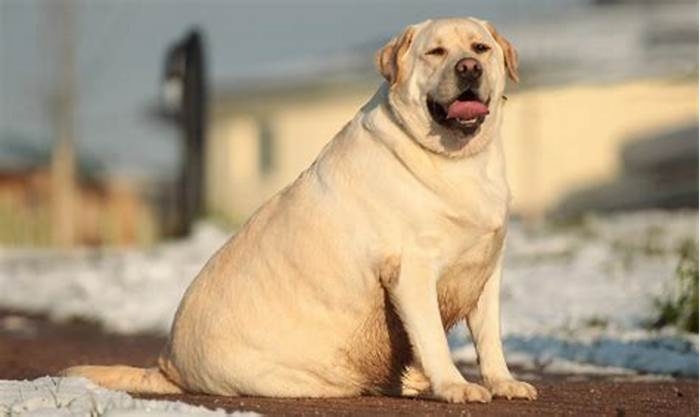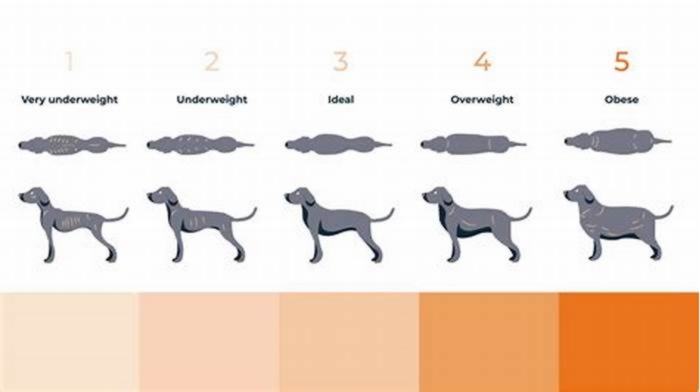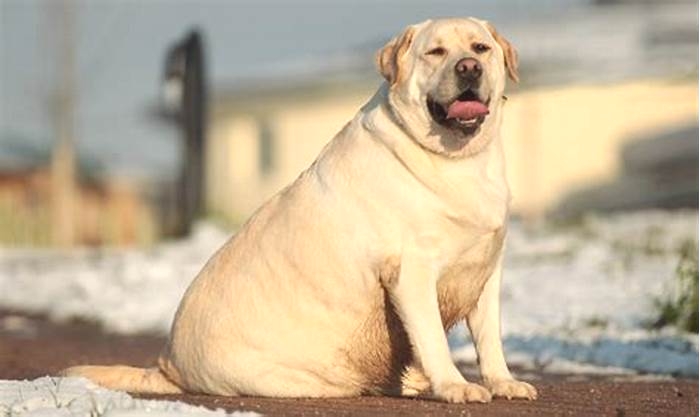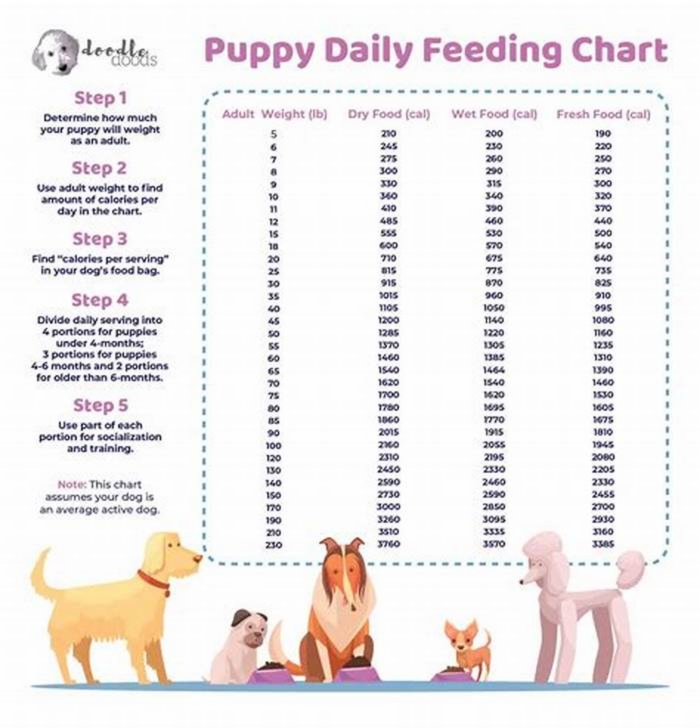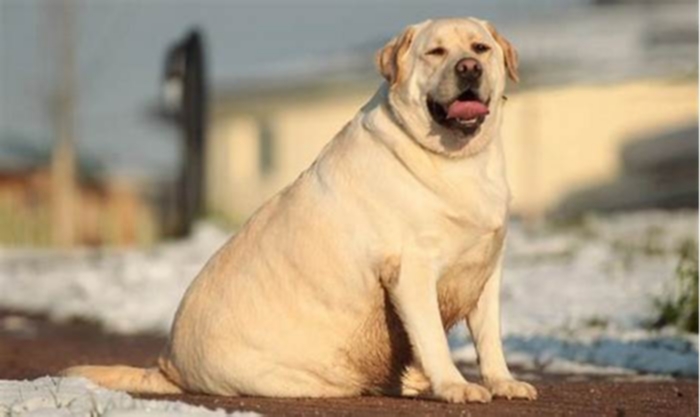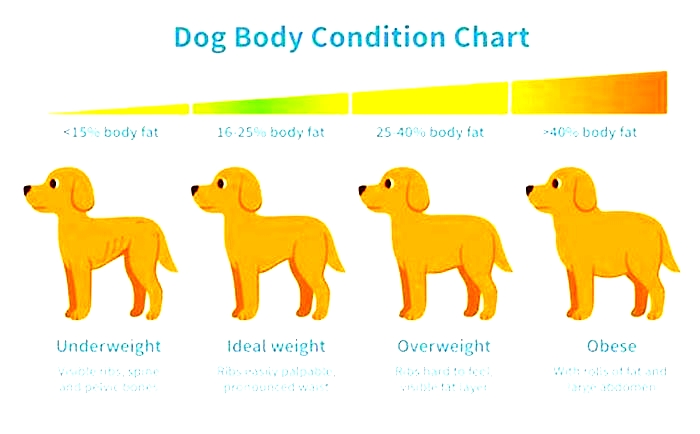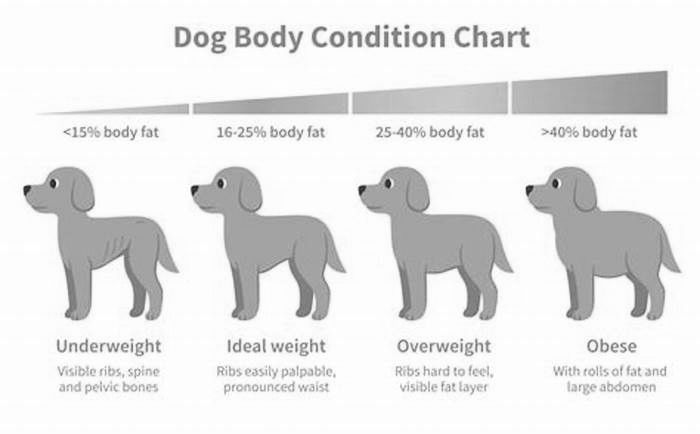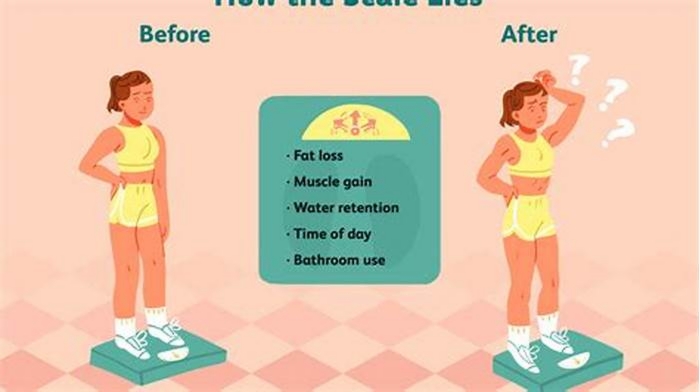How to tell if a labrador is overweight

How To Tell If Your Labrador Is Overweight and what to do about it
Worried that your Labrador is overweight? Here are the signs that he might need to drop a few pounds, and some easy ways for you to help him lose weight. Todays guest post is by Kate OBrien from the Slimdoggy website
Labradors are known for their appetites. As a result of those healthy appetites and their ability to charm humans intofeeding them, they also are known for being a little chunky or in reality, overweight.
Labs are sporting dogs and are meant to run, swim, hunt and retrieve all day long. If your Labrador is overweight, you might worry that you are limiting his ability to do these things. In order to do that they must be healthy, strong and fit, not fat. Maybe you dont hunt with your Lab; many if not most Labs are family pets, but that doesnt mean they should be couch potatoes with an extra layer or two of fat.
A growing problem
Overweight dogs are a growing problem, pun intended. In the UK it is estimated that over one-third of all dogs are overweight1 and in the US, that figure rises to an astounding 54%.2 Labs are particularly susceptible to obesity and in the US, over 60% are overweight.
Why should we worry? What difference does it make if Buddy has a few extra pounds? Well, if you love Buddy and want him to live a long life, it makes a difference.
Weight and longevity
In the first-ever lifelong canine diet restriction study, a group of Labrador Retrievers was followed for 14 years, from birth until death.
 They found that a dogs median life span can be extended by 15%, nearly two years for the Labs in the study, by restricting their diet to maintain ideal body condition.3
They found that a dogs median life span can be extended by 15%, nearly two years for the Labs in the study, by restricting their diet to maintain ideal body condition.3
By keeping your Lab lean and fit you could extend their life for TWO YEARS. Thats a lot of extra time to spend with your best friend.
A lean dog also has fewer health and joint problems. Labs have a natural propensity for hip and elbow issues but keeping them fit helps keep arthritis at bay. Other serious diseases linked to being overweight include cardiovascular disease, kidney disease, and some forms of cancer.
Is my dog too fat?
Convinced you want to keep your dog fit, but dont know how to tell if they are at the proper weight? You are not alone. In the same survey from PDSA, they report that only 17% of owners look at body shape and weight before deciding how much to feed their pet, and 85% of vets say owners have no idea of healthy body shape for their pet.4
We wanted to offer a few suggestions to help you assess the body condition of your Lab.
- The first thing is to have an honest look at them. There are numerous body conformation charts for dogs you can use as a guide. We provide links to several different at the end of this article. Whichever chart you prefer, they all depict a waistline when looking at your dog from above and a slight tuck up behind the ribs. Take that guide and go look at your dog.Many folks argue that a Lab isnt supposed to have a tuck or a waist, but that standard is for show Labs and lets be honest, some of those show dogs are overweight. The reality for most of you is that your dog isnt a show dog, so having a tuck and being leaner than the show dogs you see on TV is better for their health and longevity.
- The second evaluation you can perform is whether you feel their ribs when you run your hands lightly over the sides of your dog. Note I said lightly, you shouldnt have to press in; you should easily feel them. Actually seeing the ribs of your Lab might mean your dog is too thin, so be careful of that as well.
- The scale is the third tool to use in your assessment. Weigh your dog and ask your Vet about their weight. Many vets are reluctant to bring up the subject of your pet being overweight, but if you express your concern, they will most likely give you an honest assessment. Be open to what they say.
What should he weigh?
The average Lab will weigh somewhere between 60-85 lbs or between 27-30 kgs. Use this range as a guide but be aware that some Labs with smaller or larger bone structures can be outside of the range and still be perfectly fit and at their optimal weight. Once you have an idea of whether your Lab is overweight or not, what do you do if they are?
Feeding for health
First and foremost, you have to educate yourself about what you are feeding your dog. Reading the dog food label and following what it says doesnt work. Those labels dont take into account the current condition of your dog, their age or their exercise level, all of which are important factors in how much your dog should eat each day. And they clearly dont take into account those extra treats you give your dog!
Most people dont properly measure their dogs food or even know how many calories are in the food they give them each day.
What about exercise?
Do you have any idea how many calories your dog burns each day? How can you figure out how many calories they need to eat if you dont know how many they burn? Too much work you say, just throw a scoop or two (or three) of food in the bowl and be done with it? Thats how you end up with an overweight and unhealthy Lab.
Theres an app for that!
 Figuring this out really isnt as hard as it sounds because, of course theres an iPhone APP for that.
Figuring this out really isnt as hard as it sounds because, of course theres an iPhone APP for that.
The SlimDoggy App is a simple App with a Daily Diary that allows you to look up and track all of this information for your dog. Like a Runkeeper and Weightwatchers for dogs, the App provides average daily calorie expenditures for a dog as well as calories burned through various types of exercise. It also has a database of over 2,500 dog foods and treats.
The Diary feature allows you to create a diary for your dog and calculate exactly how much they should be eating based on their daily exercise. The food database helps you pick the healthiest diet and the proper amount of food to feed them each day.
Dont have an iPhone? No problem, visit the SlimDoggy website and use the Calorie Widget. Soon we will have a full version of the App available on the website too! There are no excuses now.
Lets have healthy labs!
We all love our Labs and we want them to be in our lives for as long as possible and we want them as healthy as possible. Dogs dont have opposable thumbs, they cant feed themselves, and it is our responsibility to feed them a healthy nutritious diet of the proper proportions so that they are lean, fit and healthy. And then instead of giving them a treat, take them for a walk that is the best way to show your Lab you love them.
Kate OBrien and her husband, Steve, live in Camarillo, CA, with their dogs SlimDoggy Jack and Maggie May, senior Lab rescues. They are animal advocates and are active in the dog rescue and foster community. They write about their adventures with their dogs and about pet obesity, health, and fitness on theSlim Doggy website,Facebook, and Twitter.
Kate has had dogs in her life since she was a child, including the collies her grandfather used to breed and show. Allergies interfered, but then in adulthood Kate was able to bring dogs back into her life. Shes had numerous Labs, a couple of litters of puppies and many Lab fosters. Shes been able to share her love of exercise and fitness with her dogs and they inspire her to help other learn about better health, nutrition & fitness for their dogs.
FURTHER RESOURCES:
FOOTNOTES
1 PDSA Animal Wellbeing Report The State of Our Pet Nation, 2013
2 Association for Prevention of Pet Obesity Annual Survey Report 2012
3 Effects of diet restriction on life span and age-related changes in dogs, Kealey, Richard et.al., JAVMA Vol 220, No. 990, May 1, 2012
4 PDSA Animal Wellbeing Report The State of Our Pet Nation, 2013
More information on Labradors
 (paid link)You can find out more about how to keep your Labrador as fit and healthy as possible in the Health section of our website.
(paid link)You can find out more about how to keep your Labrador as fit and healthy as possible in the Health section of our website.
 (paid link)
(paid link)If youd like all of The Labrador Sites best information together in one place, then get your copy of The Labrador Handbook today.
The Labrador Handbook looks at all aspects owning a Labrador, through daily care, to health and training at each stage of their life.
The Labrador Handbook is available(paid link) worldwide.
The Labrador Site Founder

Pippa Mattinson is the best selling author of The Happy Puppy Handbook, the Labrador Handbook, Choosing The Perfect Puppy, and Total Recall.
She is also the founder of the Gundog Trust and the Dogsnet Online Training Program
Pippa's online training courses were launched in 2019 and you can find the latest course dates on the Dogsnet website
How Much Should Labrador Retriever Weigh? Labrador Retriever Weight Calculator.
Updated on

Quick Links: Table of Contents
Labrador Retriever Growth
Did you just get the Labrador Retriever puppy? And do you want to know when your Labrador Retriever will stop growing and how big your Labrador Retriever will get? Or do you want to know if your Labrador Retriever is of the ideal weight for its age?
In this article, we will answer all these relevant questions related to Labrador Retriever growth and weight.
If you do not own the Labrador Retriever yet, make sure you purchase your Labrador Retriever from an reputable Labrador Retriever breeder. Also, check out our Labrador Retriever buying guide and Labrador Retriever price guide here.
You can also work with a reputable rescue to adopt a puppy.
It is important for you as a caring Labrador Retriever owner to know if your Labrador Retriever is growing normally and that your Labrador Retriever is not overweight or underweight.
Extensive
research studieshave shown that most dogs are overweight because their owners spoil them with food, treats, and easy life styles. Most dogs eat way too much and do not get enough exercise.
Researchhas also shown that one of the reasons many dogs die young is because they are overweight. However,
you can extend your dog`s life by making sure your dog is of healthy weight and growth.
One final reason to keep track of your Labrador Retriever`s weight and growth is that your Labrador Retriever`s weight and growth pattern can tell you if your Labrador Retriever has some underlying health conditions (such as bone, heart, hormone diseases). This is what recent research has shown.
This article contains the Labrador Retriever growth calculator that you can use to predict your Labrador Retriever`s adult weight. This article also contains the Labrador Retriever growth chart and weight calculator that you can use to approximately tell if your Labrador Retriever`s weight is in the normal range.
However, the more accurate method to predict and track normal growth in your Labrador Retriever is by regularly weighing your Labrador Retriever and recording the weight of your Labrador Retriever with our free dog weight tracker and weight predictor. Our tool will tell you, first, a more accurate future weight of your Labrador Retriever and, second, if your Labrador Retriever is growing normally.
We designed our dog weight tracker and weight predictor based on a recent research study carried out by researchers from Banfield Pet Hospitals and the University of Liverpool. This study collected and analyzed the weight of over 6 million healthy dogs in the United States. The dogs studied included dogs in the Labrador Retriever weight category.
Also, check out our Labrador Retriever food calculator here to know how much food to feed your Labrador Retriever based on your Labrador Retriever`s weight and age.

Labrador Retriever Weight and Growth Chart
Below is the typical growth chart and weight chart of Labrador Retrievers at different stages in their lives.
Note that your Labrador Retriever may be slightly heavier or lighter than what the chart says. The weight chart is an average weight chart.
Also, this growth chart is the combined growth chart of the male and female Labrador Retriever.
To know how much food to feed your Labrador Retriever at different ages and weights, check out our Labrador Retriever feeding guide and calculator.
To know how much water your Labrador Retriever needs to drink at different ages and weights, check out our Labrador Retriever water drinking guide and calculator.
Note that the growth pattern of a female Labrador Retriever can be slightly different from the growth pattern of a male Labrador Retriever
. Therefore, later on in this article, we will provide you with the gender-specific growth chart for the male and for the female Labrador Retriever.
| Age | Average Weight | Typical Weight Range |
|---|---|---|
| 15 Weeks | 31 LBS | 26 LBS 36 LBS |
| 20 Weeks | 40 LBS | 34 LBS 47 LBS |
| 25 Weeks | 48 LBS | 41 LBS 55 LBS |
| 30 Weeks | 54 LBS | 45 LBS 62 LBS |
| 35 Weeks | 58 LBS | 49 LBS 67 LBS |
| 40 Weeks | 61 LBS | 51 LBS 71 LBS |
| 45 Weeks | 63 LBS | 53 LBS 74 LBS |
| 60 Weeks | 66 LBS | 55 LBS 78 LBS |

When do Labrador Retrievers Stop Growing and How Big Do They Get?
Your Labrador Retriever will grow very fast in its first 45 weeks. At 45 weeks, your Labrador Retriever will have reached 95 percent of its adult weight. Then your Labrador Retriever will slowly stop adding more weight. At around 62 weeks (~14 months), your Labrador Retriever should be at its maximum weight. Labrador Retrievers stop growing at 62 weeks (~14 months).
The above discussion is general, and it applies to both male and female Labrador Retrievers. However, male dogs usually grow at a different rate compared to female dogs
A male Labrador Retriever will grow very fast in its first 47 weeks. At 47 weeks, a male Labrador Retriever will have reached 95 percent of its adult weight at 47 weeks. A male Labrador Retriever will then slowly stop adding more weight. At around 66 weeks (~14 months), a male Labrador Retriever should have reached its maximum weight. Male Labrador Retrievers stop growing at 66 weeks (~14 months).
Similarly, a female Labrador Retriever will grow very fast in its first 44 weeks. At 44 weeks, a female Labrador Retriever will have reached 95 percent of its adult weight at 44 weeks. A female Labrador Retriever will then slowly stop adding more weight. At around 58 weeks (~14 months), a female Labrador Retriever should have reached its maximum weight. Female Labrador Retrievers stop growing at 58 weeks (~14 months).
See the growth graph of a Labrador Retriever below.
As you can see in the Labrador Retriever growth curve below, the Labrador Retriever grows really fast in its early weeks, and then its growth levels off till it reaches 100 percent of the adult weight.

Labrador Retriever Growth Calculator
Use the calculator below to estimate how big your Labrador Retriever will get based on its current weight.
This Labrador Retriever growth calculator is based on the typical weight curve of a Labrador Retriever shown above. The calculator assumes that your Labrador Retriever is growing normally, and not on its way to become overweight or underweight.
How Much Should a Labrador Retriever Weigh?

Adult Labrador Retrievers typically weigh between 55 to 80 pounds.
Above is a graph that shows how much a Labrador Retriever should weigh at different ages. Check where the weight of your Labrador Retriever falls in the graph for its age.
It is totally fine if the weight of your Labrador Retriever falls in either the dark green or light green region of the graph. However, weight in the dark green region is more typical for Labrador Retrievers.
If the weight of your Labrador Retriever falls outside both the dark and light green region for its age, then you should consult a vet.
Also, you can use the Labrador Retriever weight calculator below to find the typical weight and the normal weight range of Labrador Retrievers, male or female, of any age between 12 weeks and 100 weeks.
If you want to see how the weight of your Labrador Retriever compares to that of other Labrador Retriever`s of its age, enter the weight of your Labrador Retriever in the calculator, and the calculator will show you where your Labrador Retriever stands on the weight chart.
The calculator will also tell you if your Labrador Retriever is within the normal weight range for the Labrador Retriever.
This Labrador Retriever weight calculator uses information from belpatt.fr and data from a research study on dog weight carried out by researchers at the University of Liverpool.
Please, talk to your vet before taking any decision on your pet`s weight and health.
What is the Height of the Labrador Retriever?
The adult Labrador Retriever is 21 to 24 inches at the shoulder. This is the average adult height of the Labrador Retriever.

Is Your Labrador Retriever Growing Normally? This is How to Tell
Puppy growth predictors, growth charts, and growth calculators like the ones above are approximate methods for predicting growth in dogs. However, these tools have limited capabilities. This is because each dog is unique and a dog`s growth may be different from that of the overall dog population.
A more accurate and scientific way to predict a dog`s growth is to measure the dog`s weight every week and record the weight. Doing this with your Labrador Retriever will give you a clearer picture of how your Labrador Retriever is growing.
You can use our free tool to track your Labrador Retriever`s growth and weight over time. Our tool will also let you know if your Labrador Retriever is growing normally.
Tracking your Labrador Retriever`s weight will let you see the unique growth trajectory of your Labrador Retriever. You can use this growth trajectory to accurately predict how big your Labrador Retriever will get. The growth trajectory will also let you know very early if your Labrador Retriever will become overweight or underweight.
Monitoring your dog`s weight is important because pet obesity is one of the leading causes of premature death in dogs. And these days, pets gain weight very easily because their owners spoil them with lots of treats and food. Catching early abnormal weight in your dog and correcting it (through diet changes, exercise) can significantly extend your dog`s life.
Below is what a normal growth pattern and what abnormal growth patterns look like in Labrador Retrievers. You can compare your Labrador Retriever growth trajectory against these references to see if your Labrador Retriever is growing normally or you can use our automatic tool.

to track healthy growth in your Labrador Retriever.
How to Measure the Weight of your Labrador Retriever
There are two methods you can use to measure your Labrador Retriever`s weight.
The first method, which is the better and more accurate method to weigh your Labrador Retriever, is to use a dog weighing scale.
Using a dog scale is important if you would like to monitor your Labrador Retriever`s growth regularly to catch any abnormal growth early.
Having a scale for weighing your Labrador Retriever will make it easy for you to weigh your Labrador Retriever regularly without any trouble.
The scale that we recommend for weighing the Labrador Retriever is this high durability and affordable W.C Redmon Precision Digital Pet Scale. Click here to check out this scale on Amazon.

The second method is to use a bathroom scale to weigh yourself while holding your Labrador Retriever. Then use the same scale to weigh yourself without your Labrador Retriever. Then calculate your weight when holding your dog minus your weight when not holding your Labrador Retriever. This method is illustrated in the picture below.
However, note that this method of holding your dog on a scale is not very accurate, and it may be difficult for you to use this method to weigh your Labrador Retriever if your Labrador Retriever is very heavy or if your Labrador Retriever is the type that would not stay still while being held.


How Fast Do Labrador Retrievers Grow? Labrador Retriever Growth Rate
Starting from 3 months of age, Labrador Retrievers grow at a rate of 2.22 pounds per week (1.01 Kilograms per week) on average. Starting at 4 months, your Labrador Retriever will gain 1.85 pounds (0.84 Kilograms) every week on average.
At 5 months of age, your Labrador Retriever will grow at a rate of 1.53 pounds per week (0.69 Kilograms per week) on average. Then at 6 months, your Labrador Retriever will gain 1.25 pounds (0.56 Kilograms) every week on average.
See the growth rate chart of the Labrador Retriever below
| Age (Months) | Growth per week (Pounds) | Growth per week (Kg) |
|---|---|---|
| 3 Months | 2.22 | 1.01 |
| 4 Months | 1.85 | 0.84 |
| 5 Months | 1.53 | 0.69 |
| 6 Months | 1.25 | 0.56 |
| 7 Months | 1.00 | 0.45 |
| 8 Months | 0.79 | 0.36 |
Size of Male Labrador Retriever Versus Size of Female Labrador Retriever
The average size of a male Labrador Retriever is 73 pounds (33 kg) while the average size of a female Labrador Retriever is 64 pounds (29 kg).
In general, male dogs are usually bigger than female dogs.

Male Labrador Retriever Weight and Growth Chart
The growth pattern of Male dogs is also different from that of Female dogs.
Adult male dogs are generally bigger in size than adult female dogs.
Below is the typical growth and weight chart of a Male Labrador Retriever.
| Age | Average Weight | Typical Weight Range |
|---|---|---|
| 15 Weeks | 33 LBS | 30 LBS 36 LBS |
| 20 Weeks | 43 LBS | 39 LBS 47 LBS |
| 25 Weeks | 51 LBS | 46 LBS 55 LBS |
| 30 Weeks | 57 LBS | 52 LBS 62 LBS |
| 35 Weeks | 62 LBS | 56 LBS 67 LBS |
| 40 Weeks | 65 LBS | 59 LBS 71 LBS |
| 45 Weeks | 67 LBS | 61 LBS 74 LBS |
| 60 Weeks | 71 LBS | 63 LBS 78 LBS |

Female Labrador Retriever Weight and Growth Chart
The growth pattern of female dogs is different from that of male dogs. On average, female dogs grow faster than males and reach full size earlier. For this reason, it`s important that the standard height and weight charts for dogs are gender-specific.
Also, adult female dogs are generally smaller in size than adult male dogs.
Below is the typical growth and weight chart of a Female Labrador Retriever.
| Age | Average Weight | Typical Weight Range |
|---|---|---|
| 15 Weeks | 29 LBS | 26 LBS 33 LBS |
| 20 Weeks | 38 LBS | 34 LBS 42 LBS |
| 25 Weeks | 45 LBS | 41 LBS 50 LBS |
| 30 Weeks | 51 LBS | 45 LBS 56 LBS |
| 35 Weeks | 55 LBS | 49 LBS 61 LBS |
| 40 Weeks | 58 LBS | 51 LBS 64 LBS |
| 45 Weeks | 60 LBS | 53 LBS 67 LBS |
| 60 Weeks | 62 LBS | 55 LBS 70 LBS |

Labrador Retriever Growth Stages
Your Labrador Retriever will go through a number of developmental stages on its journey to adulthood. Your Labrador Retriever`s growth pattern can be categorized into 6 distinct stages: Neonatal, Transitional, Socialization Period, Juvenile Period, Adolescent Period, and Maturity.
You can know the developmental stage of your Labrador Retriever based on how old your Labrador Retriever is.
1. Labrador Retriever Neonatal Period
Labrador Retriever Neonatal Period is from Birth to 2 weeks. During this stage, the Labrador Retriever puppy will be totally dependent on its mother. The Labrador Retriever puppy`s eyes will still be unopened with no sense of vision. The Labrador Retriever puppy will only have the senses of taste and touch
2. Labrador Retriever Transitional Period
Labrador Retriever Transitional Period is from 2 weeks to 3 weeks. During this stage, the Labrador Retriever puppy will continue to develop a better sense of hearing and taste. The puppy`s teeth will start coming through and its eyes will begin to open.
During this stage, the Labrador Retriever puppy begins to crawl forward and backward, begins to stand, begins to wag its tail. This is also the age where your puppys personality begins to develop.
3. Labrador Retriever Socialization Period
Labrador Retriever Socialization Period is from 3 weeks to 14 weeks. During this stage, the Labrador Retriever puppy will be able to fully use all of its senses (vision, smell, touch, hearing, taste), and the puppy will learn to survive without its mother.
Also during this stage, the Labrador Retriever puppy learns how to act like a dog (biting, chasing, barking, etc). The rapid learning and socialization of the puppy occur at this stage, and what the Labrador Retriever puppy learns in this stage will have a long-term effect on the puppy`s behavior as an adult.
4. Labrador Retriever Juvenile Period
Labrador Retriever Juvenile Period is from 3-4 Months to 5-14 months. During this stage, the Labrador Retriever puppies will attempt to clarify and resolve their boundaries. Their baby teeth start getting replaced by adult teeth.
5. Labrador Retriever Adolescent Period
Labrador Retriever Adolescent Period is from 5-14 Months to 2-3 Years. Labrador Retrievers go through social and sexual maturity during this stage.
6. Labrador Retriever Maturity Period
Labrador Retriever Maturity Period is from 1 year to 4 years. At this age, your Labrador Retriever will transition to full adulthood.
Male Labrador Retriever Weight/Growth Chart in KG
The growth pattern of Male dogs is also different from that of Female dogs.
Adult male dogs are generally bigger in size than adult female dogs.
Below is typical growth and weight chart of a Male Labrador Retriever in Kilograms (kg).
| Age | Average Weight | Typical Weight Range |
|---|---|---|
| 15 Weeks | 15 KG | 13 KG 16 KG |
| 20 Weeks | 19 KG | 17 KG 21 KG |
| 25 Weeks | 23 KG | 21 KG 25 KG |
| 30 Weeks | 26 KG | 23 KG 28 KG |
| 35 Weeks | 28 KG | 25 KG 30 KG |
| 40 Weeks | 29 KG | 26 KG 32 KG |
| 45 Weeks | 30 KG | 27 KG 33 KG |
| 60 Weeks | 32 KG | 28 KG 35 KG |

Female Labrador Retriever Weight/Growth Chart in KG
The growth pattern of female dogs is different from that of male dogs. On average, female dogs grow faster than males and reach full size earlier. For this reason, it`s important that the standard height and weight charts for dogs are gender-specific.
Also, adult female dogs are generally smaller in size than adult male dogs.
Below is typical growth and weight chart of a Female Labrador Retriever in Kilograms (kg).
| Age | Average Weight | Typical Weight Range |
|---|---|---|
| 15 Weeks | 13 KG | 12 KG 15 KG |
| 20 Weeks | 17 KG | 15 KG 19 KG |
| 25 Weeks | 20 KG | 18 KG 23 KG |
| 30 Weeks | 23 KG | 20 KG 25 KG |
| 35 Weeks | 25 KG | 22 KG 27 KG |
| 40 Weeks | 26 KG | 23 KG 29 KG |
| 45 Weeks | 27 KG | 24 KG 30 KG |
| 60 Weeks | 28 KG | 25 KG 31 KG |

How Much Should a 12-Week-old Labrador Retriever Weigh?
The average weight of a 12-week-old female Labrador Retriever is 23.5 lbs (10.6 kg).
The typical weight range of a 12-week-old female Labrador Retriever is from 21.0 lbs to 26.0 lbs (9.5 kg to 11.8 kg).
The average weight of a 12-week-old male Labrador Retriever is 26.3 lbs (11.9 kg).
The typical weight range of a 12-week-old male Labrador Retriever is from 24.1 lbs to 28.5 lbs (10.9 kg to 12.9 kg).
However, a recent research study on dog weight shows that 12-week-old female Labrador Retrievers can normally weigh as low as 7.5 lbs (3.4 kg) and as high as 30.6 lbs (13.9 kg)
Correspondingly, 12-week-old male Labrador Retrievers can normally weigh as low as 7.0 lbs (3.2 kg) and as high as 32.6 lbs (14.8 kg)


How Much Should a 4-Month-old Labrador Retriever Weigh?
The average weight of a 4-month-old female Labrador Retriever is 31.9 lbs (14.5 kg).
The typical weight range of a 4-month-old female Labrador Retriever is from 28.6 lbs to 35.2 lbs (13.0 kg to 16.0 kg).
The average weight of a 4-month-old male Labrador Retriever is 35.6 lbs (16.1 kg).
The typical weight range of a 4-month-old male Labrador Retriever is from 32.6 lbs to 38.5 lbs (14.8 kg to 17.5 kg).
However, a recent research study on dog weight shows that 4-month-old female Labrador Retrievers can normally weigh as low as 13.3 lbs (6.0 kg) and as high as 43.6 lbs (19.8 kg)
Correspondingly, 4-month-old male Labrador Retrievers can normally weigh as low as 13.7 lbs (6.2 kg) and as high as 48.1 lbs (21.8 kg)


How Much Should a 6-Month-old Labrador Retriever Weigh?
The average weight of a 6-month-old female Labrador Retriever is 44.6 lbs (20.3 kg).
The typical weight range of a 6-month-old female Labrador Retriever is from 39.9 lbs to 49.4 lbs (18.1 kg to 22.4 kg).
The average weight of a 6-month-old male Labrador Retriever is 49.8 lbs (22.6 kg).
The typical weight range of a 6-month-old male Labrador Retriever is from 45.5 lbs to 54.2 lbs (20.6 kg to 24.6 kg).
However, a recent research study on dog weight shows that 6-month-old female Labrador Retrievers can normally weigh as low as 22.4 lbs (10.2 kg) and as high as 62.5 lbs (28.4 kg)
Correspondingly, 6-month-old male Labrador Retrievers can normally weigh as low as 24.6 lbs (11.1 kg) and as high as 71.1 lbs (32.2 kg)


How Much Should a 1-Year-old Labrador Retriever Weigh?
The average weight of a 1-year-old female Labrador Retriever is 61.8 lbs (28.0 kg).
The typical weight range of a 1-year-old female Labrador Retriever is from 54.4 lbs to 69.2 lbs (24.7 kg to 31.4 kg).
The average weight of a 1-year-old male Labrador Retriever is 69.9 lbs (31.7 kg).
The typical weight range of a 1-year-old male Labrador Retriever is from 63.0 lbs to 76.8 lbs (28.6 kg to 34.9 kg).
However, a recent research study on dog weight shows that 1-year-old female Labrador Retrievers can normally weigh as low as 37.2 lbs (16.9 kg) and as high as 84.5 lbs (38.3 kg)
Correspondingly, 1-year-old male Labrador Retrievers can normally weigh as low as 43.7 lbs (19.8 kg) and as high as 98.3 lbs (44.6 kg)


How to Tell If Your Labrador Retriever is Overweight
As mentioned earlier in this article, a very accurate way to know if your Labrador Retriever puppy is on its way to becoming overweight is by weighing your dog every week and recording its weight. This will show you the growth trajectory of your Labrador Retriever puppy. And a close look at your puppy`s growth trajectory will tell you if your Labrador Retriever puppy will be overweight or underweight. This method is relatively easy to use.
You can use our free online tool to track your Labrador Retriever puppy`s growth curve.
However, if you do not have a record of the weekly weights of your Labrador Retriever, and you want to tell if your dog is overweight, underweight, or of normal weight, then you can use a chart called the body condition chart shown below. This method requires some expertise to use, and it is further discussed below.

To tell your dog`s body condition, first, look at your dog closely and observe which of its bones and structures are sticking out or not sticking out from under its skin. Next, use your hands to feel for fat and bones over your dog. To know which bones to look and feel for, check out the body condition tool guide from the World Small Animal Veterinary Association and this guide. This exercise will tell you the body condition score for your dog.
Body condition scores are from a scale of 1 to 9. A score of 1, 2 or 3 means that a dog is too skinny. A score of 4 or 5 means that a dog is of ideal weight, and a score above 5 means that a dog is overweight.
Talk to your vet if your Labrador Retriever appears to be overweight. The vet might recommend reducing how much food to feed your Labrador Retriever.
Conclusion on Labrador Retriever Weight and Growth
In this article, we have provided you with the information, growth charts and growth calculators to help you tell how big your Labrador Retriever will get. These tools will also help tell if your Labrador Retriever is growing normally.
However, the best way to monitor and predict the growth of your Labrador Retriever is to measure and record your puppy Labrador Retriever`s weight every week.
Use our free Labrador Retriever weight tracker and calculator tool available here to track and predict your Labrador Retriever`s weight.
It is important that every Labrador Retriever owner monitors the growth of their Labrador Retriever for normal growth by checking the weight of their Labrador Retriever regularly. Regular weight monitoring will let you detect any abnormal growth very early before it is too late. We discussed how you can tell if your Labrador Retriever is growing normally from your Labrador Retriever`s weight history earlier in this article.
Abnormal growth in Labrador Retriever can be because of underlying disease (such are heart, hormonal, or bone problems) or because of overfeeding or underfeeding. All of the aforementioned reduce the Labrador Retriever lifespan and quality of life.
Don`t wait. Start tracking your Labrador Retriever`s weight today!

